Lampung people
The Lampungese people, also commonly referred to as Ulun Lampung (Malay: Lampung, لامڨوڠ), are an ethnic group of Malays indigenous to Lampung province and parts of South Sumatra province of the southern and central region that occupy areas such as Martapura, Muaradua at upstream of Komering River, Kayu Agung, Tanjung Raja at downstream of Komering River, Merpas on the southern side of Bengkulu province, as well as Cikoneng in the southwest coast of Banten province, Indonesia. They speak the Lampung language, a Lampungic language estimated to have 1.5 million speakers.
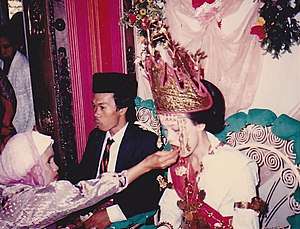 A Lampung bride and bridegroom in 1987. Both of the couples are of the Sungkai Bungamayang clan. The traditional headgear of the bride, which is called Sikei, is commonly used in Lampung weddings. | |
| Regions with significant populations | |
|---|---|
| 1,381,660[1] | |
| | 1,028,190 |
| | 92,862 |
| | 69,885 |
| | 45,215 |
| | 44,983 |
| Languages | |
| Lampung • Indonesian • Malay | |
| Religion | |
| Islam | |
| Related ethnic groups | |
| Malays | |
Origins
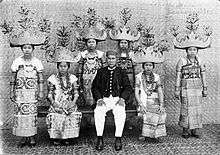
The origins of the Lampung people is closely tied to the name of Lampung itself. In the 7th century the Chinese had already mentioned about a place in the south (Nampang) where it is said to be the place of the Tolang Pohwang kingdom. To means "people" and Lang Pohwang means "Lampung". Hence its name Tolang Pohwang which means "Lampung people" or "envoy from Lampung" that came from China until the 7th century. There are strong evidence that Lampung was part of the Srivijaya kingdom with its capital in Jambi and did conquered parts of South East Asia region including Lampung until the 11th century.[2]
In the 5th AD Tai-Ping-Huan-Yu-Chi chronicles, names of the Nan-hai (Southern ocean) states were recorded and among them are two states which were mentioned in sequence, To-lang and Po-hwang. The To-lang state was mentioned only once, but the Po-hwang state was mentioned many times as this state did sent envoys to China in the year of 442, 449, 451, 459, 464 and 466.[3] According to Prof. Gabriel Ferrand (1918), it is likely that the name To-lang and Po-hwang are actually one same name and is located in Tulangbawang, Lampung.[4]
It is said that there is also a Tulangbawang kingdom, although the idea simply came from the unification of the two names in the Chinese chronicles.[5]
The earlier generation of the Lampung people came from Sekala Brak, at the foot of Mount Pesagi, West Lampung Regency. Its people were inhabited by the Buay Tumil people and they were ruled by a woman named Ratu Sekerummong. The religion of the people is animism mixed with the Javanese Bairawa Hinduism influences. After the 15th century, the Buay Tumil people later had influences from four Muslim men who came from Pagaruyung Kingdom, West Sumatra that went there. They are Umpu Bejalan Diway, Umpu Nyerupa, Umpu Pernong and Umpu Belunguh. The fourth men is the forerunner of Paksi Pak Sekala Brak as it is mentioned in an ancient manuscript, Kuntara Raja Niti. However, in the Kuntara Raja Niti manuscript, their names are Inder Gajah, Pak Lang, Sikin, Belunguh, and Indarwati. Based on the Kuntara Raja Niti, the hypothesis of the descendants of the Lampung people are as the following:[6]
| Name | Details |
|---|---|
| Inder Gajah | Title: Umpu Lapah Diway Location: Puncak Dalom, Balik Bukit. Ethnicity: Abung people |
| Pak Lang | Title: Umpu Pernong Location: Hanibung, Batu Brak. Ethnicity: Pubian people |
| Sikin | Title: Umpu Nyerupa Location: Tampak Siring, Sukau. Ethnicity: Jelma Daya |
| Belunguh | Title: Umpu Belunguh Location: Kenali, Belalau. Ethnicity: Peminggir |
| Indarwati | Title: Puteri Bulan Location: Cenggiring, Batu Brak. Ethnicity: Tulangbawang |
Customs
Originally the lineage of the Lampung people came from Sekala Brak. However, in its customary sense the Lampung people developed and became two people group, namely the Saibatin Lampungs and the Pepadun Lampungs. The customs of the Saibatin people are well known for its aristocracy, while the customs of the Pepadun people which emerged later followed the practices of the Abung people and had democracy values developed in opposed to the aristocracy values held by the Saibatin people.
Saibatin Lampungs
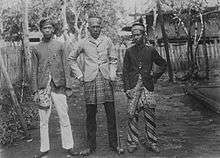
The Saibatin Lampungs occupy traditional regions such as Labuhan Maringgai, Pugung, Jabung, Way Jepara, Kalianda, Raja Basa, Teluk Betung, Padang Cermin, Cukuh Balak, Way Lima, Talang Padang, Kota Agung, Semaka, Suoh, Sekincau, Batu Brak, Belalau, Liwa, Pesisir Krui, Ranau, Martapura, Muara Dua, Kayu Agung with four of these cities are in South Sumatra province, Cikoneng in Pantai Banten and including Merpas in South Bengkulu Regency. The Saibatin Lampungs are also often referred to as Pesisir (coastal) Lampungs because majority of them lived along the east, south and west coast of Lampung with each consisting of:-
- Keratuan Melinting (East Lampung Regency)
- Keratuan Darah Putih (South Lampung Regency)
- Keratuan Putih Bandakh Lima Teluk Semaka in Cukuh Balak, Limau, Kelumbayan, Kelumbayan Barat, Kedondong, Way Lima, Way Khilau, Pardasuka, Pardasuka Selatan, Bulok, Talang Padang, Gunung Alif and part of Padang Cermin, Punduh Pedada, Teluk Betung and Kalianda (Tanggamus - Pesawaran - Pringsewu - South Lampung Regency) which consist of:
- Bandakh Seputih, which are Buay Humakhadatu, Buay TambaKukha, Buay HuluDalung, Buay HuluLutung, Buay Pematu, Buay Akhong and Buay Pemuka
- Bandakh Sebadak, which is Buay Mesindi (Tengklek)
- Bandakh Selimau, which are Buay Tungau, Buay Babok and Buay Khandau
- Bandakh Sepertiwi, which are Buay Sekha, Buay Samba and Buay Aji
- Bandakh Sekelumbayan, which are Buay Balau (Gagili), Buay Betawang and Buay Bakhuga
- Keratuan Komering (South Sumatra)
- Cikoneng Pak Pekon (Banten)
- Paksi Pak Sekala Brak (West Lampung Regency)
Pepadun Lampungs
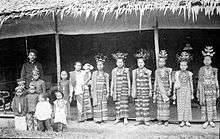
The Pepadun Lampungs or Pedalaman (interior) Lampungs consists of:-
- Abung Siwo Mego (Unyai, Unyi, Subing, Uban, Anak Tuha, Kunang, Beliyuk, Selagai, Nyerupa). The Abung people lived in seven traditional regions, which are Kotabumi, Seputih Timur, Sukadana, Labuhan Maringgai, Jabung, Gunung Sugih, and Terbanggi.
- Mego Pak Tulangbawang (Puyang Umpu, Puyang Bulan, Puyang Aji, Puyang Tegamoan). The Tulangbawang people lived in four traditional regions, which are Menggala, Mesuji, Panaragan, and Wiralaga.
- Pubian Telu Suku (Minak Patih Tuha or Manyarakat people, Minak Demang Lanca or Tambapupus people, Minak Handak Hulu or Bukujadi people). The Pubian people lived in eight traditional regions, which are Tanjungkarang, Balau, Bukujadi, Tegineneng, Seputih Barat, Padang Ratu, Gedungtataan, and Pugung.
- Sungkay-Way Kanan Buay Lima (Pemuka, Bahuga, Semenguk, Baradatu, Barasakti, who are the five descendants of Raja Tijang Jungur). The Sungkay-Way Kanan people lived in nine traditional regions, which are Negeri Besar, Ketapang, Pakuan Ratu, Sungkay, Bunga Mayang, Blambangan Umpu, Baradatu, Bahuga, and Kasui.
Philosophical life
The philosophical life of the Lampung people are contained in the Kuntara Raja Niti manuscript,[7] which are:-
- Piil-Pusanggiri: It is an embarrassment to do despised job in accordance to religion and self-esteem.
- Juluk-Adok: A personality that is fitting to the customary title that one bears.
- Nemui-Nyimah: To keep in touch with one another by visiting and by gladly receiving guests.
- Nengah-Nyampur: Active in communal fellowship and not being individualistic.
- Sakai-Sambaian: Give mutual assistance with one another in the community.
The above-mentioned philosophical values are denoted by the symbol of five decorative flowers of the Lampung seal.
The characteristic traits of the Lampung people are expressed in the adi-adi (poems):-
Tandani ulun Lampung, wat piil-pusanggiri
Mulia heno sehitung, wat liom ghega dighi
Juluk-adok gham pegung, nemui-nyimah muaghi
Nengah-nyampugh mak ngungkung, sakai-Sambaian gawi.
Language
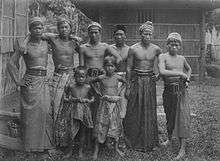
The Lampung language is the language used by the Lampung people in Lampung, southern Palembang and the west coast of Banten. This language is classified in its own branch from the western Malayo-Polynesian languages (Lampungic languages)[8] and is most closely related to Malay, Sundanese and Javanese.[9] The Lampung language has two major dialects which is Api and Nyo dialects.[10] The Api dialect are spoken by the people of Sekala Brak, Melinting Maringgai, Darah Putih Rajabasa, Balau Telukbetung, Semaka Kota Agung, Pesisir Krui, Ranau, Komering and Daya (those that practices the Saibatin Lampungs customs), and including Way Kanan, Sungkai and Pubian (those that practices Pepadun Lampungs customs). The Nyo dialect are used by the people of Abung and Tulangbawang (those that practices Pepadun Lampungs customs). According to Dr. Van Royen, there are two classification of the Lampung language which are the Belalau dialect or Api dialect and the Abung dialect or Nyo dialect.[11] Komering, spoken by the Komering is also part of Lampungic languages but mostly considered an independent language of its own, separate from proper Lampung as the Komering people have a different culture from Lampung people.[12]
Lampung script
Lampung script that is referred to as Had Lampung is a form of writing that is related to the Pallawa script from South India.[13] Just like a form of syllable-based phonetic writing similar to the vowels as used in Arabic letters by using the sign of fathah at the top row and the sign of kasrah at the bottom row but does not use the sign of dammah on the front row unless the mark is used at the back, with each mark has its own name.
This shows that Lampung script is influenced by two elements, namely the Pallawa script and Arabic script. The Lampung script also has a form of kinship with Rencong script, Rejang script,[13] Bengkulu script and Bugis script.[14] Had Lampung consists of main letters, sub-letters, double letters and consonant clusters, as well as also symbols, numbers and punctuation. Lampung script is also referred to as KaGaNga, a term for a script that is written and read in a direction from left to right with 20 main letters.
Lampung script has developed or changed. Previous ancient Lampung script is much more complex. Refinement were made until it has become to what it is now known. The Lampung script or alphabet that is being taught in the school today is the result of that refinement.
Notable Lampung people
Statesmen and politicians:
- Alamsjah Ratoe Perwiranegara
- Aburizal Bakrie
- Ryamizard Ryacudu
- Alzier Dianis Tabranie
- Bagir Manan
- Tursandi Alwi
- Siti Nurbaya
- Edward Syah Pernong
Professional practitioners:
- Henry Yosodiningrat
- Andi Arief
- Julian Aldrin Pasha
Artists and humanists:
- Anshori Djausal
- Hila Hambala
- Andi Ahmad Sampurna Jaya
- Firman Al Hakim (Lampung's most well known guitarist)
- Iwan Nudaya Djafar
- Daman Hori BS
Academicians and educationist:
- Alhusniduki Hamim
- A. Effendi Sanusi
- Irfan Anshori
- Hilman Hadikusuma
- Wahyu Dani
Reporters and journalists:
- Bambang Eka Wijaya
- Isbedy Stiawan ZS
- Oyos Saroso HN
- Udo Z. Karzi
Heros of freedom fighters:
- Radin Inten II (Keratuan Darah Putih)
- Pangeran Abdul Malik (Krui)
- Pangeran Siagul Agul (Krui)
- Batin Mangunang (Semaka)
- Djafar Husein
References
- "Kewarganegaraan, Suku Bangsa, Agama, dan Bahasa Sehari-hari Penduduk Indonesia 2011" (PDF). Badan Pusat Statistik. 2010. Retrieved 2017-06-10.
- Bukri Fachruddin (1992). Pengendalian Sosial Tradisional Daerah Lampung. Departemen Pendidikan dan Kebudayaan, Direktorat Jenderal Kebudayaan, Direktorat Sejarah dan Nilai Tradisional, Bagian Proyek Penelitian, Pengkajian dan Pembinaan Nilai-Nilai Budaya Daerah Lampung.
- Nia Kurnia Sholihat Irfan (1983). Kerajaan Sriwijaya: Pusat Pemerintahan Dan Perkembangannya. Girimukti Pasaka. p. 37. ASIN B0000D7JUN.
- Titik Pudjiastuti (1997). Aksara Dan Naskah Kuno Lampung Dalam Pandangan Masyarakat Lampung Kini. Departemen Pendidikan dan Kebudayaan RI.
- Prof. Purbatjaraka (1952). Riwajat Indonesia I. Jajasan Pembangunan. p. 25.
- Seminar Sejarah Nasional IV: Sub Tema Studi Bandingan. Departemen Pendidikan dan Kebudayaan, Direktorat Sejarah dan Nilai Tardisional. 1985. p. 77.
- Ahmad Fauzie Nurdin (2009). Budaya muakhi dan pembangunan daerah menuju masyarakat bermartabat. Gama Media. ISBN 979-1104-26-3.
- Harry van der Hulst; Rob Goedemans & Ellen van Zanten, eds. (2010). A Survey of Word Accentual Patterns in the Languages of the World. Walter de Gruyter. p. 707. ISBN 31-101-9896-7.
- Dale F. Walker (1976). A Grammar of the Lampung Language: The Pesisir Dialect of Way Lima. Nusa; linguistics studies in Indonesian and languages in Indonesia. p. 1. OCLC 783766160.
- Ni Nyoman Wetty (1992). Struktur Bahasa Lampung Dialek Abung. Pusat Pembinaan dan Pengembangan Bahasa, Departemen Pendidikan dan Kebudayaan. p. 1. ISBN 97-945-9201-3.
- Proyek Inventarisasi dan Dokumentasi Kebudayaan Daerah (1986). Adat Istiadat Daerah Lampung. Departemen Pendidikan dan Kebudayaan, Kantor Wilayah Propinsi Lampung, Proyek Inventarisasi dan Dokumentasi Kebudayaan Daerah Lampung. pp. 50–51.
- William Frawley (2003). International Encyclopedia of Linguistics: 4-Volume Set. Oxford University Press. p. 387. ISBN 01-951-3977-1.
- Stephen A. Wurm; Peter Mühlhäusler & Darrell T. Tryon, eds. (1996). Atlas of Languages of Intercultural Communication in the Pacific, Asia, and the Americas: Vol I: Maps. Vol II: Texts. Walter de Gruyter. p. 681. ISBN 31-108-1972-4.
- Jane Garry & Carl R. Galvez Rubino, eds. (2001). Facts about the World's Languages: An Encyclopedia of the World's Major Languages, Past and Present. H.W. Wilson. p. 96. ISBN 08-242-0970-2.
Further reading
- Ahmad Fauzie Nurdin (1994), Fungsi Keluarga Bagi Masyarakat Lampung Dalam Meningkatkan Kualitas Sumber Daya Manusia, Departemen Pendidikan dan Kebudayaan, Kantor Wilayah Propinsi Lampung, Bagian Proyek Pengkajian dan Pembinaan Nilai-Nilai Budaya Lampung, OCLC 67317529
- Toto Sucipto (2003), Kebudayaan Masyarakat Lampung Di Kabupaten Lampung Timur, Kementerian Kebudayaan dan Pariwisata, Balai Kajian Sejarah dan Nilai Tradisional Bandung, Proyek Pemanfaatan Kebudayaan Daerah Jawa Barat, OCLC 82367280
| Wikimedia Commons has media related to People of Lampung. |